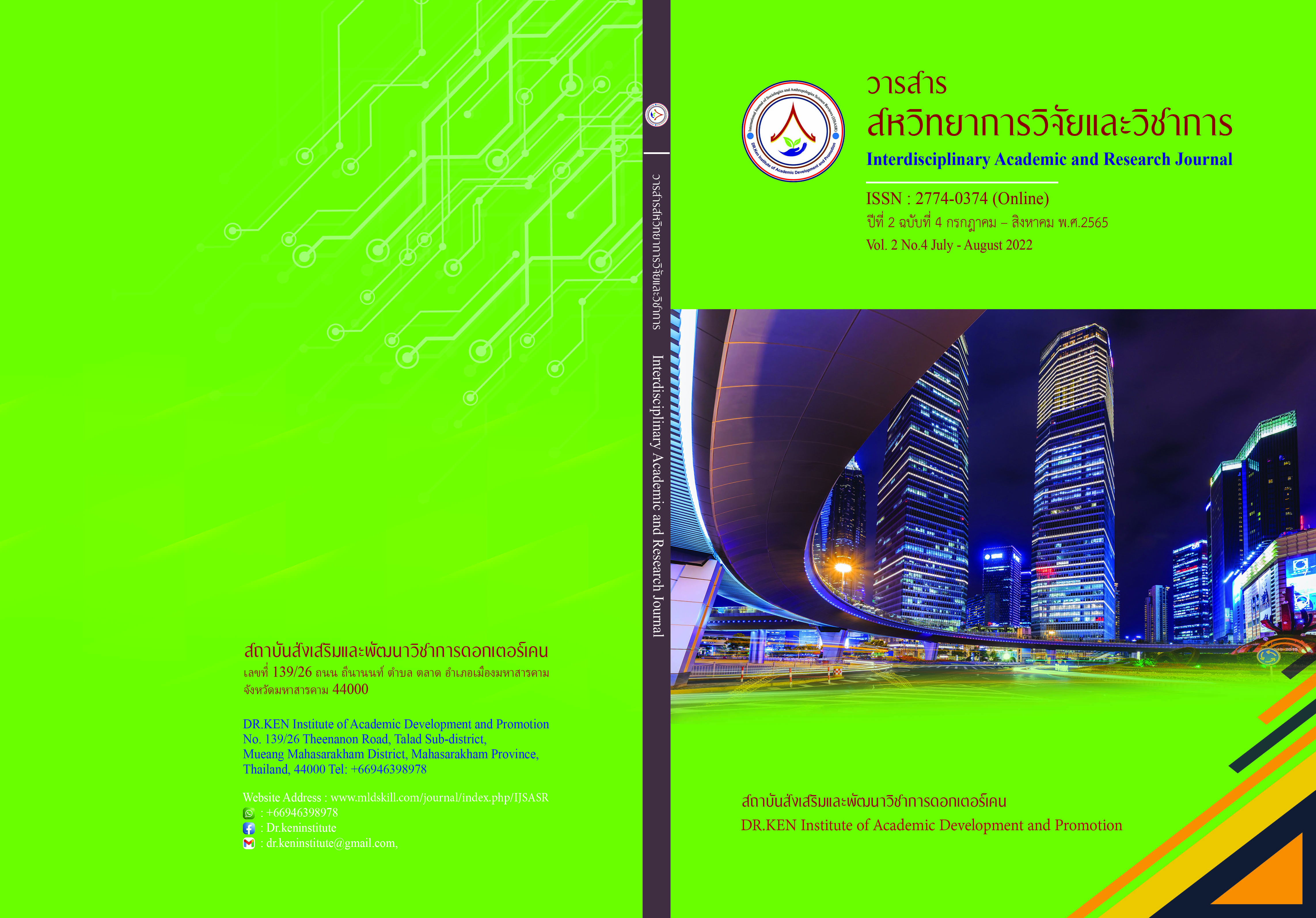Management Development of Communities Retail Business in Yala Province
DOI:
https://doi.org/10.14456/iarj.2022.62Keywords:
Business Development; , Retail Store; , DevelopmentAbstract
The important role of a retail business operator is to create added value of goods or services to generate profits for the business. In addition to being a business that helps develop and drive the country's economy, it is also a business that is a cultural symbol of the community in the local life. Therefore, this research aimed to 1) investigate the needs for the development of community retail enterprises in Yala Province; 2) develop retail business operations, and 3) evaluate the development of business operations. The three steps consist of 1) investigation of challenges and needs for business development; 2) business development by applying interview results to business operations; and 3) assessment of development by questioning the satisfaction of business operators, customers, and students. 1) According to the findings of the study, local retailers continue to sell a variety of products without price tags and without a stock management system. The arrangement of products on the shelves is disorderly. There is no categorization and classification of products. There are other products on the store's floor, but no other services are offered. The need for development has revealed that businesses require expertise in the field of product management to determine which items are the most popular. 2) Development operations with a focus on development in three areas: product development by educating the selection of products to be broader and more suited for the location and customer base; exploring adopting locally-made or popular OTOP items; and the price tag should be marked clearly. Determine the item number proportionally based on sales and manage inventory using the first-in, first-out concept of retail management development through product design and categorization instruction. The people of Yala Province are pleased with the expansion of retail establishments, and they want to learn more so they can apply what they discover to their own enterprises. Furthermore, customers are pleased with the evolution of retail outlets, which makes it easier for them to locate the things they require. Cleaner stores are also more convenient. It has a significant effect on the image of community retail. The students, who are a sample group to explore the outcome of the development of satisfaction of community retail enterprises in Yala Province, are pleased really with the ability to apply classroom information in real-world settings.
References
กฤษณ์ ทัพจุฬา. (2558). ความสำเร็จของธุรกิจร้านค้าปลีกแบบดั้งเดิมในเขตกรุงเทพมหานคร. วารสารวิชาการ มหาวิทยาลัยกรุงเทพธนบุรี, 3 (2), 108-119.
ดวงเดือน สัญญะ. (2561). ความสำคัญของธุรกิจค้าปลีก. [Online] http://www.thaigoodview.com/library/teachershow/utaradit/daungduarn-s/cloths/sec02p03.html [28 มีนาคม 2563]
นรภัทร สถานสถิต และจรรยา วังนิยม. (2562). ปัจจัยที่มีผลต่อศักยภาพการแข่งขันของร้านค้าปลีกแบบดั้งเดิม เขตอำเภอแกลง จังหวัดระยอง. วารสารวิทยาการจัดการปริทัศน์, 21 (2), 11-22.
นรินทร์ ตันไพบูลย์. (2564). ธุรกิจร้านค้าปลีกสมัยใหม่. [Online] https://www.krungsri.com/th/research/industry/industry-outlook/ Wholesale-Retail/Modern-Trade/IO/io-modern-trade-21 [5 สิงหาคม 2564]
นิธิพัฒน์ สุทธิธรรม. (2555). กลยุทธ์การแข่งขันสำหรับธุรกิจค้าปลีกไทย. วารสารวิชาการบัณฑิตวิทยาลัยสวนดุสิต, 8 (1), 147-157.
บุญฑวรรณ วิงวอน, อัจฉรา เมฆสุวรรณ และบุญชนิต วิงวอน. (2559). อิทธิพลของภาพลักษณ์ร้านค้า คุณค่าความสัมพันธ์ พฤติกรรมการบริการและการซื้อซ้ำที่มีต่อความภักดีของลูกค้าในร้านค้าปลีกดั้งเดิม. วารสารสมาคมนักวิจัย, 21 (2), 69-83.
พัชราภรณ์ เลขยันต์. (2560). กลยุทธ์การตลาดเพื่อการแข่งขันสำหรับธุรกิจค้าปลีก. วารสารวิทยาการจัดการ มหาวิทยาลัยราชภัฏสวนสุนันทา, 4 (1), 8-12.
ภาวิณี กาญจนาภา. (2554). การบริหารส่วนประสมการค้าปลีกและการจัดการเชิงกลยุทธ์การตลาดของร้านค้าปลีกแบบดั้งเดิม. วารสารบริหารธุรกิจคณะพาณิชยศาสตร์และการบัญชี มหาวิทยาลัยธรรมศาสตร์, 34 (132), 37-57.
มนตรี พิริยะกุล และบุญฑวรรณ วิงวอน. (2553). ตัวกำหนดการรับรู้ผลการดำเนินงาน การรับรู้ถึงความรับผิดชอบต่อสังคมการรับรู้คุณภาพของสินค้า/บริการ และพฤติกรรมการเป็นลูกค้าที่ดีของห้างค้าปลีกสมัยใหม่ในเขตภาคเหนือตอนบนของประเทศไทย. วารสารบริหารธุรกิจศรีนครินทรวิโรฒ. 1 (1), 20-44.
มหาวิทยาลัยราชภัฏยะลา. (2565). ปรัชญา วิสัยทัศน์ พันธกิจ. [Online] สืบค้นเมื่อ 28 มีนาคม 2563 จาก www.yru.ac.th/th/about-us.
รัชนี สิทธิศักดิ์. (2561). การเรียนรู้ผ่านโครงงานบริการชุมชน Learning through community service projects. วารสารนาคบุตรปริทรรศน์ มหาวิทยาลัยราชภัฏนครศรีธรรมราช, 10 (s), 146-157.
สรายุทธ สุคนธ์คันธชาติ. (2561). การจัดการของผู้ประกอบการร้านค้าปลีกท้องถิ่น ในเขตตำบลสาวะถี อำเภอเมือง จังหวัดขอนแก่นต่อการส่งเสริมเศรษฐกิจชุมชน ด้านช่องทางการตลาดของผลิตภัณฑ์ OTOP. ในการประชุมวิชาการเสนอผลงานวิจัยระดับชาติและนานาชาติ ครั้งที่ 8 วันที่ 20 มีนาคม 2561 มหาวิทยาลัยราชภัฏสวนสุนันทา.
สันติธร ภูริภักดี. (2554). กลยุทธ์การตลาดเพื่อการแข่งขันสำหรับธุรกิจค้าปลีก. วารสารนักบริหาร. 31 (3), 193-202.
สุจินดา เจียมศรีพงษ์. (2554). ธุรกิจค้าปลีกแบบดั้งเดิม (ร้านโชห่วย) : ปัญหาและทางแก้ไข. วารสารวิทยาการจัดการและสารสนเทศศาสตร์, 6 (1), 9-23.
อัปสร อีซอ, กัลยรัตน์ พินิจจันทร์, สุธิดา เลขาวิจิตร์ และศุภมาส รัตนพิพัฒน์. (2563). ปัญหาและความต้องการเพื่อการพัฒนาของผู้ประกอบการค้าปลีกธงฟ้าประชารัฐ จังหวัดยะลา. วารสารวิทยาการจัดการ มหาวิทยาลัยราชภัฏนครปฐม, 7 (1), 31-41.
อารีย์ นัยพินิจ, สุกานดา นาคะปักษิณ, ภัทรขวัญ พิลางาม, ภัทรวดี เพิ่มวณิชกุล, เทียนทิพย์ บัณฑุพาณิช, เกศินี วิเชียรชัย, พิไลวรรณ ปักเคนัง, ปฏิพัทธ์ ทองพรหม, ประกายทิพย์ แสงชาย และรตินันท์ อินทร์มณี. (2563). การปรับปรุงและพัฒนาร้านค้าปลีก : กรณีศึกษา ร้านต้นอ้อยมินิมาร์ท. วารสารวิทยาลัยบัณฑิตเอเชีย, 10 (3), 80-86.
Levy, Michael, and Barton A. Weitz. (2007). Retailing management. Boston, MA: McGraw-Hill/Irwin.
Downloads
Published
How to Cite
Issue
Section
License
Copyright (c) 2022 Ganyarat Pinichchan, Paweena Jeharong, Abdullahman Sa-lae

This work is licensed under a Creative Commons Attribution-NonCommercial-NoDerivatives 4.0 International License.
Copyright on any article in the Interdisciplinary Academic and Research Journal is retained by the author(s) under the under the Creative Commons Attribution-NonCommercial-NoDerivatives 4.0 International License. Permission to use text, content, images, etc. of publication. Any user to read, download, copy, distribute, print, search, or link to the full texts of articles, crawl them for indexing, pass them as data to software, or use them for any other lawful purpose. But do not use it for commercial use or with the intent to benefit any business.
















.png)


